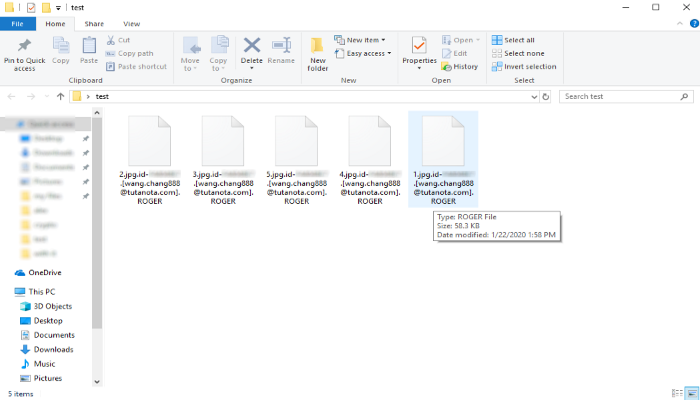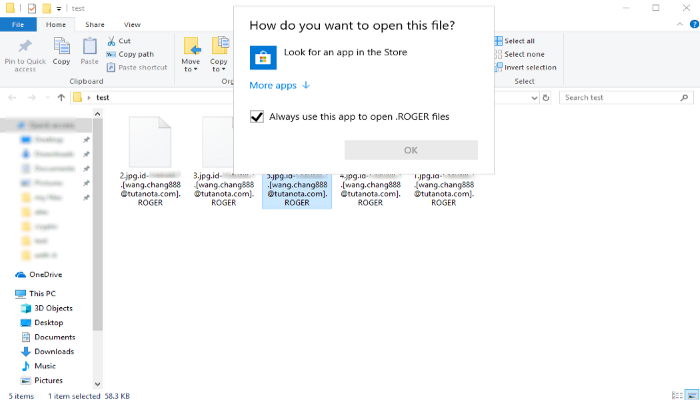What does .ROGER mean?
A great number of users recently faced the new threat. It’s called ROGER ransomware and the clearest sign of the infection with this virus is the “.*id*.[wang.chang888@tutanota.com].ROGER” extension. As the rule, it spreads by the means of various fake installators. Such files can be easily downloaded from numerous file sharing services and torrent trackers. Moreover, hackers can easily hide the code of the virus into common and harmless files, and spread it by the means of email attachments. There is also a tendency nowadays: hackers begin to use various remote access software widely. Such soft is usually distributed in bundles, the terms of installation of which usually are not clear. Remote access soft gives to hackers an opportunity to infect computers remotely. If the virus successfully snuck into the operating system, it begins to make changes in the registry in order to hide its malicious processes from the built-in protection. Then ROGER ransomware begins the scanning of the hard drive. It looks for the files that are suitable for encryption (commonly such files are all document formats and various media files) and then modifies their structures. As the result, files get the new – “.*id*.[wang.chang888@tutanota.com].ROGER” extensions. We strongly recommend you to avoid any contact with the hackers! Once they’ve been payed they stop all contacts with the victims in general, however, they can easily make the situation much worse. They can send you a malicious program instead of the decryptor and even damage your files and system! That’s why it’s important to remove ROGER ransomware as soon as possible. For this purpose we’ve prepared the detailed guide on how to remove ROGER ransomware and decrypt .*id*.[wang.chang888@tutanota.com].ROGER files!
Article’s Guide
- How to remove ROGER Ransomware from your computer
- How to decrypt .*id*.[wang.chang888@tutanota.com].ROGER files
- Data Recovery
- Automated decryption tools
- Other software
How to remove ROGER Ransomware from your computer?
We strongly recommend you to use a powerful anti-malware program that has this threat in its database. It will mitigate the risks of the wrong installation, and will remove ROGER ransomware from your computer with all of its leftovers and register files.
Solution for Windows users: our choice is Norton 360 . Norton 360 scans your computer and detects various threats like ROGER, then removes it with all of the related malicious files, folders and registry keys.
If you are Mac user, we advise you to use Combo Cleaner.
How to decrypt .*id*.[wang.chang888@tutanota.com].ROGER files?
Once you’ve removed the virus, you are probably thinking how to decrypt .*id*.[wang.chang888@tutanota.com].ROGER files or at least restore them. Let’s take a look at possible ways of decrypting your data.
Restore .*id*.[wang.chang888@tutanota.com].ROGER files with Data Recovery

- Download and install Data Recovery
- Select drives and folders with your files, then click Scan.
- Choose all the files in a folder, then press on Restore button.
- Manage export location.
The download is an evaluation version for recovering files. To unlock all features and tools, purchase is required ($49.99-299). By clicking the button you agree to EULA and Privacy Policy. Downloading will start automatically.
Decrypt .*id*.[wang.chang888@tutanota.com].ROGER files with other software
Unfortunately, due to the novelty of ROGER ransomware, there are no decryptors that can surely decrypt encrypted files. Still, there is no need to invest in the malicious scheme by paying a ransom. You are able to recover files manually.
You can try to use one of these methods in order to restore your encrypted data manually.
”Decrypt.ROGER files with Emsisoft decryptor”]
This software includes information about more than 100 viruses of STOP(DJVU) family and others. All that you need are two files or some luck. You can freely use it as it distributes free of charge. If it doesn’t work for you, you can use another method.




